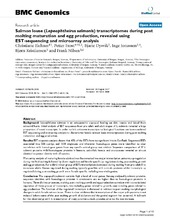| dc.description.abstract | Background Lepeophtheirus salmonis is an ectoparasitic copepod feeding on skin, mucus and blood from salmonid hosts. Initial analysis of EST sequences from pre adult and adult stages of L. salmonis revealed a large proportion of novel transcripts. In order to link unknown transcripts to biological functions we have combined EST sequencing and microarray analysis to characterize female salmon louse transcriptomes during post molting maturation and egg production. Results EST sequence analysis shows that 43% of the ESTs have no significant hits in GenBank. Sequenced ESTs assembled into 556 contigs and 1614 singletons and whenever homologous genes were identified no clear correlation with homologous genes from any specific animal group was evident. Sequence comparison of 27 L. salmonis proteins with homologous proteins in humans, zebrafish, insects and crustaceans revealed an almost identical sequence identity with all species. Microarray analysis of maturing female adult salmon lice revealed two major transcription patterns; up-regulation during the final molting followed by down regulation and female specific up regulation during post molting growth and egg production. For a third minor group of ESTs transcription decreased during molting from pre-adult II to immature adults. Genes regulated during molting typically gave hits with cuticula proteins whilst transcripts up regulated during post molting growth were female specific, including two vitellogenins. Conclusion The copepod L.salmonis contains high a level of novel genes. Among analyzed L.salmonis proteins, sequence identities with homologous proteins in crustaceans are no higher than to homologous proteins in humans. Three distinct processes, molting, post molting growth and egg production correlate with transcriptional regulation of three groups of transcripts; two including genes related to growth, one including genes related to egg production. The function of the regulated transcripts is discussed in relation to post molting morphological changes in adult female salmon louse. There is clear evidence that transcription of the major yolk proteins is not induced before some of the post molting growth of abdomen and the genital segment has occurred. A hallmark for the observed growth is transcription of many putative cuticula proteins prior to the size increase. | en_US |
